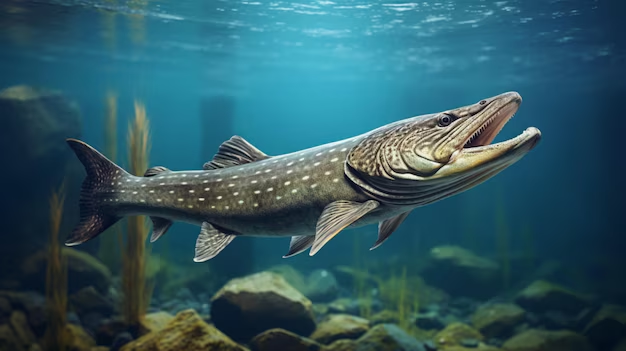A

Amur Pike
The Amur pike, also known as the Amur pikeperch or Korean pike, is a species of freshwater fish native to eastern Asia, particularly the Amur River basin in China, Russia, and Korea. Here are some key characteristics and facts about the Amur pike:
- Appearance: The Amur pike has a long, slender body with a pointed snout and sharp teeth. It has a greenish to brownish coloration with darker blotches or stripes along its sides. It resembles a pike in appearance but is actually a member of the perch family (Percidae).
- Habitat: Amur pike inhabit rivers, lakes, and reservoirs with slow-moving or stagnant water. They prefer areas with submerged vegetation or structures where they can hide and ambush prey.
- Diet: Amur pike are carnivorous predators, feeding on a variety of small fish, crustaceans, and insects. They are ambush hunters, lying in wait for passing prey and striking quickly with their sharp teeth.
- Reproduction: Spawning in Amur pike typically occurs in the spring when water temperatures rise. Females release eggs, which are fertilized by males externally. The eggs adhere to submerged vegetation or substrate until they hatch into larvae.
- Commercial and Recreational Importance: Amur pike are an important fish species for both commercial and recreational fishing in their native range. They are valued for their firm, white flesh and are targeted by anglers using a variety of fishing techniques, including bait fishing and lure fishing.
- Conservation Status: The conservation status of Amur pike populations varies depending on the region and local threats. While they are not currently considered threatened or endangered, they may face habitat loss, pollution, and overfishing in some areas.
- Cultural Significance: In addition to their ecological and economic importance, Amur pike hold cultural significance in some indigenous communities along the Amur River basin, where they are often depicted in folklore and art.
Overall, the Amur pike is a fascinating fish species with ecological, economic, and cultural importance in its native range. Efforts to conserve and sustainably manage their populations are essential for ensuring their long-term survival and the health of freshwater ecosystems.
Related posts:
Wonder Nature
0





 Total views : 3580
Total views : 3580